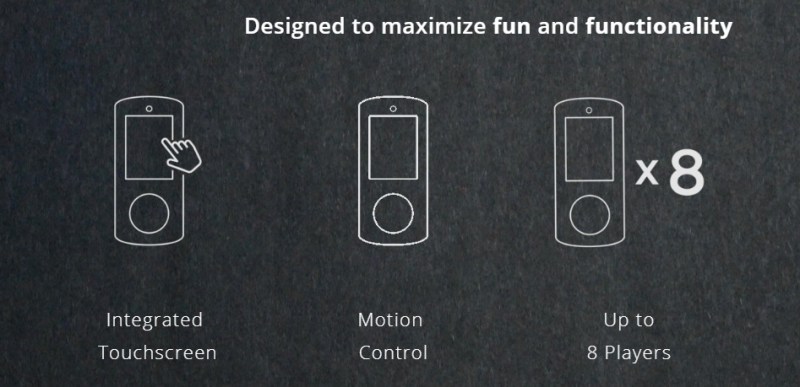Tommy Tallarico has been making noise and music as a sound expert and musician for video games for more than three decades.
But lately, he has been leading a retro gaming revival as head of Intellivision Entertainment, which is building Amico, a new version of the famous retro game console from the 1980s. 2020 is going to be a big year in that effort, as Tallarico has committed to launching the new machine on October 10, or as Tallarico likes to say, “10/10/20.”
Tallarico also found himself at odds with Roblox over the Roblox “death sound,” a comical “oof” noise that has become famous to the 100 million kids who play games in the virtual gaming world. Tallarico says he originally created the sound in 1999 for use in the Messiah video game that came out in 2000.
He forgot about it until he learned recently that it has become an iconic sound for Roblox, which never asked his permission to use it. Tallarico is trying to negotiate with Roblox to get some royalties out of the company, but he says negotiations aren’t going well.
June 5th: The AI Audit in NYC
Join us next week in NYC to engage with top executive leaders, delving into strategies for auditing AI models to ensure fairness, optimal performance, and ethical compliance across diverse organizations. Secure your attendance for this exclusive invite-only event.
Tallarico spoke at the 2020 Kids@Play and FamilyTech Summit at CES 2020, the big tech trade show in Las Vegas last week, and I interviewed him ahead of that session.
Here’s an edited transcript of our interview.

Above: Intellivision Amico — bringing back a classic console.
GamesBeat: How things are going now?
Tommy Tallarico: It’s great. Here’s the latest controller. We decided to, in the hardware — we moved the buttons here. This is still a 3D printout, but these are the molds. The buttons light up. The gyroscope is working. You can see all the fun stuff there, the touch screen. The disc, which I don’t think you’ve seen working yet — a normal D-pad is eight positions. Up, down, left, right, and diagonals. We have 64 positions. You can see that there. We have pressure on it as well.
GamesBeat: Sixty-four positions, is that harder to do?
Tallarico: Exactly. When you’re skiiing, for example, and you’re going like this — it’s like an analog stick. But with analog sticks, it always pulls back to the center. When you play a game like Missile Command, for example, or Centipede, in the old days you’d use the trackball and roll it around. In the last 25-30 years, you either had to use a D-pad, which was crap, or you would have to use the analog stick. But the analog stick, it’s always pulling back to the center.
This is the great thing about the controller. For our Missile Command, we can just use this. Now, wherever your thumb goes — it’s so much easier. And this can become a fire button. This can be Centipede. Or if you’re a lefty it can be like this. If you prefer trigger buttons it can be like this. It’s whatever you want it to be. What’s interesting is when we give these to little kids. They hold it like this automatically, because they’re used to a phone. When you give it to millennials, they automatically hold it like a PlayStation controller.
We decided to go with a capacitive touch screen, which bumped our build and materials up. This is a resistive touch, but we’re going with the glass touch as well. It’s just more responsive. We felt like it was so important that this be perfect. We decided to spend some more money and switch over. I tried to get it for CES, but we just couldn’t do it in time.
All of the retailers are super-excited. Wal-Mart and Best Buy and GameStop. GameStop and Wal-Mart are probably our two biggest fans right now. We’re appealing — the whole idea is to bring families together. We’re not necessarily appealing to the hardcore gamer. Our go-to-market strategy is to go after moms who have young kids. Most GameStops are in malls. Who’s shopping between 9 in the morning and 3 in the afternoon? It’s moms with young kids. Even GameStop tells us that moms will walk in at noon with their 4 year old and say, “Do you have anything for my 4 year old?” What are they gonna sell them?
We’re in an interesting time in history in that Baby Boomers were the No. 1 generation on the planet. Their kids are millennials. Their kids took over last year. Millennials are now the No. 1 age group on the planet. Millennials are all in their early 30s now. As you know, they found their careers later. They got married later, left the home later, had kids later. In the U.S. alone, there are 21 million households that have children between the ages of two and seven. That’s never happened before. In Europe, there’s another 21 million. If you add Canada and Mexico, all of North America and Europe, there are 65 million households that have kids between the ages of two and seven.
In regards to a home console, Xbox and PlayStation are more for teenagers. They start to get the Switch around eight, 10 years old. Even Roblox and Minecraft are 7, 8, 9. A lot of our strategy is, let’s also have games — yes, we have the retro reimagined stuff we’re doing. Yes, we have tons of sports and recreational games. Not only baseball, football, soccer, but cornhole and bowling and darts and pool. All those recreational games. Tons of board games, whether it’s Yahtzee or Farkle or Wheel of Fortune or things like that.

Above: Intellivision Amico controller has its classic control disc.
Let’s take a game like Texas Hold ‘Em for example, where everyone has their two cards on the controller and the flop is on the screen. This is the kind of stuff that’s never been before. What if you have dice in a Farkle game? You see the dice and shake it when it’s your turn. You throw it and it goes up on the screen. Every game we’re making is unique to our controller. They cannot be put on a PlayStation or Xbox or Switch or mobile.
All of the edutainment, like all of the hypercasual stuff, is only on mobile. Again, you read the information, the statistics, and the number one concern of parents with young kids is that they give them too much screen time. This becomes the babysitter. The parents give it to the kid, but they want to limit it. Then the kid gets hooked. That’s our whole thing. Play with your children. You’ll be able to play simple, affordable games together. That’s our tagline: “Together again.” You see it everywhere on all our stuff.
GamesBeat: You said more than 100 games?
Tallarico: There’s going to be about 40 games at launch. Then every 10 to 14 days, we’ll come out with one game at a time. We’re never going to release two games at once. Keep in mind, it’s a closed system. We’re going to be announcing, at E3, all of our licenses. It’s all the greatest licenses you can imagine in one place. Not only for kids, but for adults. There’s a lot of stuff that people are going to be delightfully surprised by.
GamesBeat: How would you compare and contrast this to competition like the Atari boxes?
Tallarico: They’re in a whole different realm. I still haven’t seen an original game on their system and they’re supposed to ship in a couple of weeks. I think they’re going for this sandbox — I view it as almost like a Raspberry Pi on steroids, a really amazing super-fast kind of tinkerer’s thing. I would love for Atari to succeed so that we can, after 40 years, kick their asses. [Laughs] Round two of the original console war!
I’ll share a little secret with you. We announced that we’re going to do a founder’s edition. We’ll take preorders on it at the end of the month, in a couple of weeks. It’s going to be a limited number, and that limited number is 2600. They’ll all be hand-signed and numbered and the whole thing. So yeah, I think it’ll be fun. I say this all with tongue in cheek, but I think it would be fun to relive the original console war. But have fun with it. Of course I don’t have any ill will toward anyone. I think what they’re doing is something very different, obviously, than what we’re doing. We’ll see if there’s a market for what they’re doing too.

Above: Intellivision Amico details
GamesBeat: How are you doing on which territories to reach?
Tallarico: We’re launching in North America, Europe, and potentially the Middle East, all at the same time. That’s our plan right now. We’re also talking to Australia, that area. I was in China for a week. We met with the Chinese government, some big players over there, about potentially — over in China they’re very family-oriented. If you think we have problems over here with mobile screen time, over there it’s a whole other level. When we were talking to them about our solution, they flipped out. They loved it.
So we’re talking to China as well because no one’s been able to break the Chinese market. I know Tencent and Nintendo are trying the Switch now. We’ll see how that works. But again, for us, those young families, there’s a whole bunch of them over there as well.
GamesBeat: How many people have you grown the company to now?
Tallarico: We have about 35 people in-house. Last time we talked it was probably around 20 or so. We have more than 300 people in development working on games for us.
GamesBeat: A smaller group of people can make each game.
Tallarico: That’s the beauty of it. We’re not making Call of Duty or Red Dead 2. The style of games that I showed you, the Earthworm Jims — look at our Earthworm Jim game back then. A programmer, two or three artists, an audio guy, producer, designer. You’re talking about teams of six to 10 people. Something like Farkle, a dice game or card game, you’re talking about five or six months. Some of the more in-depth games, nine months to a year.
We got $1 million from the Bavarian government over in Germany. That’s where our European home office is, in Nuremberg. They give us $1 million because they loved the idea and the concept so much. We have to spend that money on development in Germany. We’re working on seven games for that money. That gives you an idea — again, you’re talking about seven to 10 people working for nine months. Our budgets are $150,000, $200,000, maybe $250,000 on the high end. It’s a completely different business model.
Most indie developers who are designing for mobile or PC, they’re either bootstrapping it from scratch, sweat equity, living in mom’s basement while they do it, or six guys in a dorm room together, or they’re going to Kickstarter and crowdfunding to get their dream realized. We’re coming along saying, “Wow, we like that. Can we make it unique for our system?”
Everything on the system is exclusive. That doesn’t mean that — if we’re doing a game like our version of Breakout, it doesn’t mean there won’t be another Breakout. But our Breakout that we’re doing, that we’re paying for, that we’re designing, that we’re making for couch co-op, that we’re using our screen and gyroscope to do, that version cannot be played — not that it won’t be, but it can’t be. The way we’re designing all our games, it’s specific to this. You’ll either like it or not. A hardcore gamer might be turned off. A lot of people hated motion controls on the Wii, and a lot of people loved it.
We’re going to stay in our lane. We know what we’re good at. We know what we can accomplish. We don’t feel that anyone else is doing it like we’re doing it.
GamesBeat: How do you feel about the reality of the up-front investment for you? Is that turning out as you expected?
Tallarico: It’s interesting. Anyone who’s gone through creating a startup, especially something as big and crazy as this, there’s always — it never ends. The money raising never ends. But we have so much passion. Everyone in the company, everything we’re doing, it’s going along great.
Is it perfect? No. It’s never perfect. It’s always, something we think will happen doesn’t happen, but something we never thought would happen comes through. It’s hard. It’s difficult. I’ll be honest. But if this was easy then everyone would do it. We have the team that — we have no fear. We know that we’’re going to hit tons of roadblocks along the way. For us, it’s a matter of not giving up or quitting when we hit those roadblocks. Okay, how are we going to get over it, go around it, dig underneath? How are we going to get by this?
We understand that there will be rough roads and hard decisions we have to make. The best thing we can do is keep trucking and keep doing the best we can.
GamesBeat: You can collect some extra financing from Roblox for this.
Tallarico: [Laughs] Let’s hope so! It’s interesting. You did a story on it. Roblox admits to distributing my property to hundreds of millions of people, which then turned into a worldwide meme and videos and helped to draw — tens of millions of people found out about Roblox because of this sound and the memes. Imagine the billions of dollars in marketing that they got from this one sound that spread around the world.
That’s the thing. Like I told Roblox, I said, “Look, if it was just some footstep sound effect and nobody cared, that’s a different thing than a sound that’s literally. …” I mean, they do T-shirts and bedspreads and pillows. It’s become the whole face of the franchise. It’s become a pop culture phrase. I’m asking for a number. They don’t like the number. We aren’t even in the same atmosphere.
By the way, it’s important for me to say this and get this across. I don’t hate Roblox. The community is obviously younger people. They come after me on social media because they feel, “Hey, you’re going to ruin this game. They’re going to have to take out the sound because of you, so I hate you and I want you to die.” I get that. It’s a younger audience. I’m not mad at Roblox or this or that. It’s a business thing. I feel that over the last 15 years, distributing this to hundreds of millions of people, this is worth something. They feel it’s worth something else. Hopefully we can come together and meet somewhere in the middle. If not, then I have no problem taking them to court. Again, we’re 100 times apart. Literally 100 times.
GamesBeat: Maybe they can pay you off in games developed for Intellivision.
https://www.youtube.com/watch?time_continue=46&v=tX0eU64Ai4w&feature=emb_logo
Tallarico: I was going to say, maybe we’ll see Roblox coming exclusively to Intellivision. You never know! I’d love to talk to them about that, seriously. Maybe we bring a version of Roblox. Whatever it takes. But I want it to stay friendly. I respect them. Their community is so passionate. As much as some of them don’t like me now, because they think I’m going to take their sound away — which, by the way, I’m not. I’ve never sent a cease and desist. I’ve never sent anything to Roblox saying, “Take that out or else.” Never. All I’m saying is, “Guys, why don’t you buy this sound from me?” Then everything is worked out. I get money. They get this iconic thing that’s become the face of the franchise. All the fans remain happy. Hopefully that’ll work out.
GamesBeat: I hope it’s not a distraction for you.
Tallarico: Not really. I have a team of attorneys, copyright attorneys. They deal with this stuff all the time. It doesn’t take away, really. I’m having a little fun with it, to be honest. I’m doing a YouTube live stream this Saturday at 10 in the morning on my YouTube channel where I invited all the community of Roblox. It’s such an iconic sound. I said, “Hey, there’s a couple of secrets about that sound that no one knows and that I’d like to talk about.”
I didn’t just put a microphone up to somebody and throw them against a wall and they went “Oof!” The amount of things that we did to get that particular sound, and all of the voices of the character Bob in Messiah, it’s a very cool process. It was like a 20-step process. But there’s something cool about the Roblox sound that people don’t know. I’ll reveal that on Saturday.


